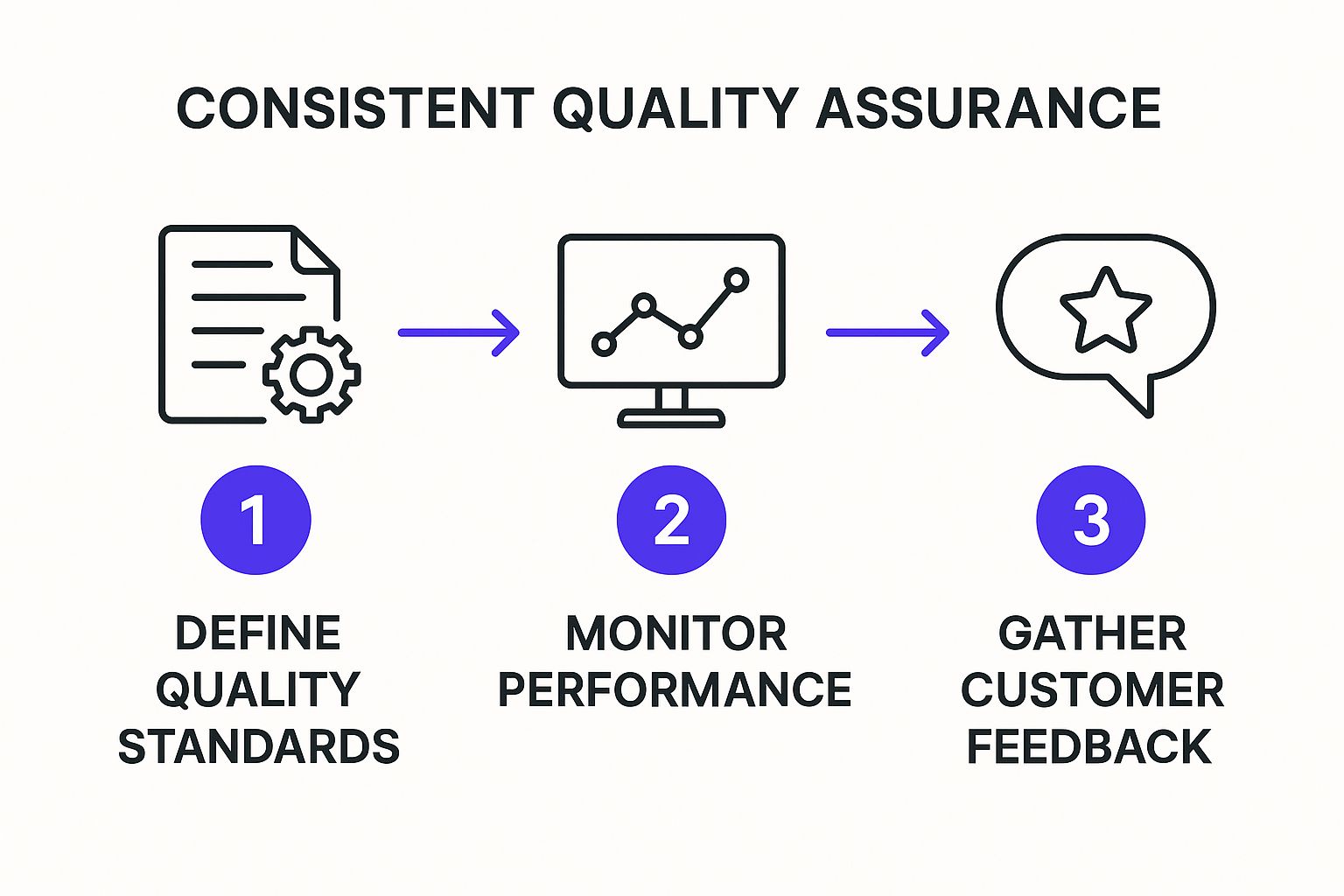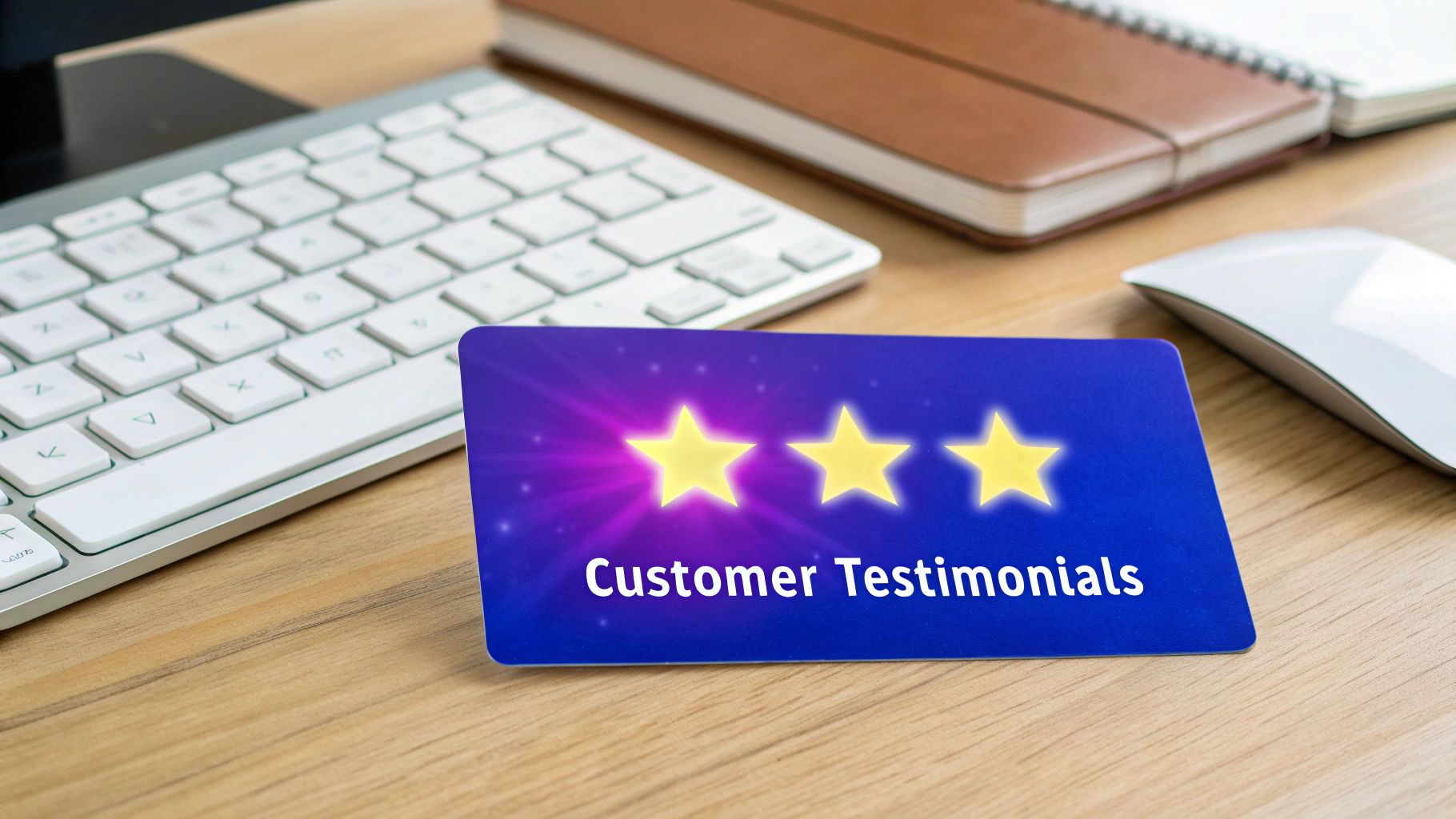A Modern Guide to Build Trust with Customers
Learn how to build trust with customers using proven strategies. Our guide covers transparency, consistency, and leveraging social proof for lasting loyalty.
Posted by
Let's be honest, in a market flooded with options, trust isn't just a nice-to-have. It's the bedrock of your business. It’s what separates a one-time buyer from a lifelong advocate and, frankly, it’s what keeps your brand from becoming just another commodity.
Why Customer Trust Is Your Most Valuable Asset
Trust is what happens when you move past just satisfying a customer and into the realm of real, human connection. It's the quiet confidence a customer has that you’ll do the right thing—that you’ll deliver on your promises, own up to your mistakes, and always act with their best interests at heart.
This isn’t some fuzzy, unmeasurable feeling. It has a direct, tangible impact on your bottom line.
Today's customers don't just buy products; they invest in brands that mirror their own values. They're smart, they're watching, and they're quick to call out anything that feels inauthentic. This shift in consumer behavior means trust is no longer a soft skill—it’s a hard metric you can’t afford to ignore.
The Foundation of Trust
So, how do you actually build it? It really boils down to three core principles that you have to live and breathe every single day.
- Authenticity: Showing up as your genuine self. It means being true to your brand's values, even when it’s hard or unpopular.
- Reliability: This is all about consistency. It's about meeting (or even better, exceeding) expectations with every single touchpoint, from the first ad they see to the support ticket they submit a year later.
- Transparency: Operating with a level of openness that builds confidence. You communicate honestly, you share the good and the bad, and you don’t hide from your mistakes.
These aren't just buzzwords to toss around in a meeting. They are the active ingredients for building real, lasting trust. If you skimp on one, the whole structure starts to feel shaky.
Don't just take my word for it. A recent Edelman Trust Barometer found that a staggering 71% of global consumers say that trust is a deal-breaker when deciding whether to buy from a brand. That's a huge number, and it shines a spotlight on just how deeply purchasing decisions are tied to this very human emotion.
To give you a clearer picture of how these elements work together, here's a quick breakdown.
The Core Pillars of Customer Trust
This table sums up the foundational elements we've been talking about. Think of it as a quick-reference guide for keeping your trust-building efforts on track.
| Pillar | What It Means for Your Business | Key Action |
|---|---|---|
| Authenticity | Your brand has a clear identity and consistently acts in line with its values. | Define and communicate your core brand values across all channels. |
| Reliability | Customers can count on you to deliver quality products and services consistently. | Implement strong quality control and predictable customer service processes. |
| Transparency | You operate with honesty and openness, especially when things go wrong. | Proactively communicate about business changes, challenges, and mistakes. |
By focusing on these three pillars, you're not just improving your brand's image; you're building a resilient business that can weather storms and foster genuine, long-term loyalty.
Trust is the belief that a company will deliver on its commitments and operate with integrity. It's the ultimate currency in modern business, directly impacting customer loyalty, retention, and your brand's reputation.
Ultimately, seeing trust as an essential business objective is the first and most important step. Our complete guide on how to build customer trust dives even deeper into turning this powerful asset into sustainable, predictable growth. In today's conscientious marketplace, mastering these principles isn't optional—it's the playbook for winning.
Practice Radical Transparency and Authenticity

If you want to build real, lasting trust with your customers, you need to ditch the polished, curated perfection. It's time to embrace something far more powerful: radical transparency.
This isn't just about being honest when things are going great. It’s about being honest when it’s hard. It’s about operating with a level of openness that makes your customers feel like they're insiders, not just another number on a sales report.
This isn’t just a feel-good strategy; it’s what the market is screaming for. Trust in corporations is tanking, largely because people are fed up with shady product quality and a lack of authenticity. Younger consumers are especially wary, with widespread accusations of "greenwashing" making them second-guess any brand’s big claims. People don't just want to buy from companies anymore; they want to believe in them. You can dive deeper into these consumer trends at Innova Market Insights.
To get this right, you can't just react when you're called out. You have to build authenticity into the very fabric of your brand.
Share Your Flaws—and Your Fixes
Honestly, one of the fastest ways to build trust is to just be upfront about where you’re falling short. If a product has a known limitation, don’t bury it in the fine print. Talk about it. Explain why it's there and what you're doing to make it better.
Imagine a software company launching a new feature. Instead of pretending it’s perfect, they could send an email that says, "Our new analytics tool is live! Right now, it works best with datasets under 10,000 records. We're already working on scaling this up and will let you know as soon as it's ready for bigger projects."
That single move prevents a ton of customer frustration and instantly makes them seem more credible. The same logic applies whenever you mess up. A shipping delay, a website crash, a buggy update—get ahead of it.
- Own It Immediately: Don't wait for the complaints to roll in. Post a notice or send a clear, honest email.
- Explain What Happened: Keep it simple. No corporate jargon. Just a straightforward explanation.
- Show Your Work: Tell them exactly what you’re doing to fix it and make sure it doesn’t happen again.
This approach turns a potential PR nightmare into a moment that actually strengthens your relationship with your customers.
“Authenticity is not about being perfect; it's about being honest about your imperfections. When you openly admit a mistake, you show customers you respect them enough to tell the truth.”
Weave Your Values into Everything You Do
Real authenticity is also about living your company values, not just sticking them on an "About Us" page. Your values should be obvious in your marketing, your customer support chats, and even your product roadmap.
Claim you value sustainability? Show people your supply chain. Say you champion community? Spotlight how you're actually investing in it.
Here’s how to make it real:
- Define Actionable Values: Go beyond vague words like "integrity." What does integrity look like day-to-day in your business?
- Communicate Them Consistently: Use your blog, social media, and newsletters to share stories that show your values in action.
- Empower Your Team: Make sure every single employee understands your values and feels empowered to make decisions that align with them.
When customers see that you’re consistent, they start to believe you are who you say you are. That connection is the bedrock of loyalty—and it’s a competitive advantage no amount of marketing spend can buy.
Secure Digital Trust by Protecting Customer Data
Let's talk about something that can make or break your relationship with customers: their data. In our digital-first world, how you handle their personal information speaks volumes about your brand's integrity. This isn't just about ticking a legal box; it's a foundational pillar of trust. One misstep, one data breach, and the confidence you've worked so hard to build can shatter in an instant.
And the stakes are higher than you might think. Consumer trust is fragile. A recent Thales Digital Trust Index revealed that a staggering 82% of consumers ditched a brand in the last year specifically because they were worried about how their personal data was being used. That statistic should be a wake-up call. A proactive, transparent approach to data security isn't just good practice—it’s essential for survival.
Make Privacy Your Policy
A dense, jargon-filled privacy policy hidden in your website's footer isn't fooling anyone. It certainly isn't building confidence. If you want to earn trust, you need to be transparent. That means creating a policy that’s easy to find, easy to read, and easy to understand.
Use plain English. Tell people exactly what data you collect, why you need it, and how you're keeping it safe.
"A clear, accessible privacy policy is more than a legal document; it's a promise to your customers. It says, 'We respect you and your data, and we have nothing to hide.' This simple act of clarity is a powerful trust-builder."
But don't stop there. Empower your customers by giving them control. Provide straightforward options to manage their data preferences, access their information, or opt out entirely. A deep focus on understanding privacy policies shows customers you take their security seriously and aren't just trying to meet the bare minimum.
Communicate Your Security Efforts Proactively
Don't wait for a crisis or for customers to start asking questions about your security. Talk about it openly and often. Let them know about the robust protocols you have in place. When you do this, you turn a backend necessity into a frontline, trust-building asset.
A simple framework for this involves defining your standards, keeping an eye on performance, and using feedback to get better. This creates a cycle of continuous improvement that keeps customer data safe.

This kind of proactive communication shows you're on top of things. A strong security posture is also a massive part of protecting your brand's image. To learn more about how all these pieces fit together, check out our guide on online reputation management for small business.
Here are a few practical things you can do right now:
- Implement Robust Security: This means using tools like encryption, secure servers, and running regular security audits to protect data from threats.
- Train Your Team: Make sure every single employee understands why data privacy is so important and knows the best practices for handling sensitive information. One weak link can compromise everything.
- Be Transparent About Breaches: If the worst happens and a breach occurs, communicate quickly and honestly. Explain what happened, what you're doing to fix it, and how you'll prevent it from happening again.
When you make data protection a visible and respected part of your brand, you’re sending a clear message: your customers' trust is your top priority.
Deliver Relentlessly Consistent Experiences

So you've nailed authenticity and locked down your data security. Those are huge wins, but they won't mean much if your customer experience feels like a rollercoaster. To really forge lasting trust, you have to deliver on your brand promise every single time.
Consistency is the quiet, hardworking engine of trust. It’s what makes customers feel safe and confident in their decision to choose you over a competitor.
Think about it from their side. When they know exactly what to expect—from the quality of your product to the tone of your support team—they don't have to waste mental energy second-guessing their purchase. That kind of reliability is priceless. It removes uncertainty and replaces it with a feeling of security, which is the bedrock of any long-term relationship. This is how you stop being just another transaction and start becoming a trusted partner.
Creating a Unified Brand Voice
Your brand can't afford to have a split personality. That friendly, casual tone on your Instagram has to match the helpful, clear voice in your email support. When it doesn't, the experience is jarring and it subtly erodes trust. A customer starts to wonder, "Which one is the real company?"
To make sure every interaction reflects your brand's core promise, you absolutely need to be implementing a comprehensive brand style guide. This isn't just about picking logos and colors; a great guide defines:
- Voice and Tone: How does your brand sound? Are you witty and informal, or more formal and authoritative? You need to provide clear examples for different scenarios.
- Core Messaging: What are the key phrases and value propositions that should appear everywhere, from your ads to your FAQs?
- Customer Service Etiquette: How should your team greet customers? How do they handle complaints? What's the sign-off?
When you create this playbook, you empower your entire team to be a consistent ambassador for your brand. Suddenly, every touchpoint—from a splashy marketing ad to a mundane support ticket—feels like it comes from the same cohesive company.
A consistent brand experience is about making your business predictable in the best way possible. Customers trust what they can rely on, and a unified voice across all channels is a powerful signal of your reliability and professionalism.
Operationalizing Your Quality Control
Here’s the thing: consistency doesn't happen by accident. It's the direct result of deliberate, well-designed processes. You have to build systems that make high quality the default outcome, not a happy coincidence. This means setting clear, measurable standards for every single part of your customer journey.
Start by mapping out the key interactions. What should a customer experience when they:
- Visit your website for the first time?
- Receive their product or service?
- Contact customer support with a problem?
For each of these stages, you need to define what "good" actually looks like. For example, a quality standard for customer support might be: "All inquiries answered within 2 hours with a personalized, non-scripted response."
Once you’ve defined these standards, you have to monitor your performance against them. Use customer feedback to find and fix any gaps. This is how you turn reliability from a hopeful goal into a core operational function, reinforcing the idea that you’re a brand that can truly be counted on.
Amplify Customer Voices with Social proof
Let’s be honest. When you want to build trust, your own marketing messages can only take you so far. People naturally expect you to say great things about your own brand. It's your job.
What they really trust is what other people have to say—people just like them. This is the core of social proof, and it's one of the most powerful tools you have for building genuine customer trust.
This isn't about just grabbing a few glowing quotes and slapping them on your homepage. It's about building a system to actively collect and showcase real customer experiences. You’re weaving their voices directly into your brand's story, giving skeptical buyers the third-party validation they need to feel confident enough to click "buy."
Harness the Power of Authentic Reviews
In today's market, authentic reviews are the currency of trust. When a potential customer sees genuine, unvarnished feedback, it instantly lowers their perceived risk.
And the key word here is authenticity. A perfect wall of flawless five-star reviews can sometimes feel less credible than a mix of overwhelmingly positive feedback with a few constructive critiques sprinkled in. It shows you’re a real business with real customers.
To get started, you need to make the review process completely painless.
- Automate Your Requests: Use a tool to automatically send a review request about a week or two after a purchase. This timing is crucial—it gives the customer enough time to actually experience your product's value.
- Remove All Friction: The request should link directly to the review platform. Don't make them hunt for it. One click should be all it takes.
- Prompt with Questions: Instead of a generic "How did we do?", guide them with specific questions. Try asking, "What was the main problem you were hoping to solve with our product?" or "What was your favorite feature and why?"
This simple shift in approach gives you richer, more detailed testimonials that go way beyond a simple "It was great!" and provide real substance for your next potential buyer.
Social proof works because it taps into a fundamental human behavior called informational social influence. When we're unsure how to act, we look to others for cues. Seeing that others have had a positive experience with your brand provides a powerful shortcut to trust.
Elevate Your Story with Video Testimonials
While text reviews are a great foundation, video testimonials take trust-building to a whole new level.
There's just something about seeing and hearing a real person share their success story. It creates an emotional connection that text simply can’t replicate, turning an abstract review into a compelling, human-centered narrative.
But let's face it, asking a customer for a video can feel like a big ask. This is where a platform like EndorseFlow makes a world of difference. It simplifies the entire process, allowing customers to record and submit a video from their phone in just a few minutes, which completely removes the technical hurdles that stop most people.
Our guide on how to boost sales with customer video testimonials shows you exactly how to turn these authentic stories into assets that truly convert.

Showcasing a collection of video testimonials, like you can with the EndorseFlow platform, creates a powerful visual tapestry of customer satisfaction. By integrating these genuine voices across your site, you turn passive visitors into engaged prospects who see undeniable proof of your value.
This strategy goes beyond just testimonials. In the 'trust economy,' turning your existing customers into advocates through referral marketing is incredibly effective. You can learn more about how referral marketing leverages customer trust to turn your happiest customers into a reliable growth engine.
When you amplify these authentic voices, you create a positive feedback loop where trust builds on itself, attracting new customers who are already primed to believe in what you do.
Frequently Asked Questions About Customer Trust
Even with the best strategy in place, you're bound to run into some tricky questions when it comes to building genuine customer trust. Let's tackle some of the most common ones I hear from brands to give you some extra clarity.
How Long Does It Take to Build Trust with Customers?
Honestly? It's a marathon, not a sprint. While a stellar first impression can definitely create an initial spark of confidence, real, lasting trust is something you earn over months and years of being consistently reliable.
Think of it like a bank account. Every positive experience—a great support call, a product that just works—is a deposit. You slowly build up a healthy balance. But one major screw-up, like a data breach or a moment of dishonesty, can wipe that account clean in an instant.
The key is to stop thinking of trust-building as a project with a finish line. It has to be a core part of your company's DNA, forever.
What Is the Single Most Important Factor for Building Trust?
If I had to boil it all down to one thing, it would be consistency.
You can talk all day about transparency and authenticity, but without a reliable track record, those are just buzzwords. Customers need to know they can count on you, time and time again.
This isn't just about one thing; it's about everything:
- Product Quality: Does your product deliver on its promises every single time?
- Customer Service: Is the support experience predictably helpful and empathetic?
- Brand Messaging: Are your communications and actions always aligned with your stated values?
Reliability is the foundation. It’s what proves your promises are more than just marketing copy, creating the stability you need for everything else to work.
Can I Use AI to Help Build Trust with Customers?
Absolutely, but you have to be smart about it. AI can be a fantastic ally, helping you personalize customer interactions at scale, offer 24/7 support through chatbots, and even analyze feedback to spot problems before they escalate.
The golden rule here is transparency. AI should always support the human element, not try to replace it. Be upfront when a customer is interacting with a bot, and always provide an easy, frictionless escape hatch to a real person for complex or emotional issues.
After all, empathy and genuine connection are human skills. Use AI to handle the routine stuff so your team can focus on the relationships that truly matter.
How Do I Recover Trust After Making a Mistake?
It might sound strange, but handling a mistake the right way can actually make your customer relationships stronger. It's a moment to prove your company’s character when things get tough.
Recovering lost trust requires humility, transparency, and decisive action. First, acknowledge the mistake quickly and openly—don't hide it. Second, take full responsibility and offer a sincere apology. Third, communicate what went wrong and what specific steps you are taking to fix the issue and prevent it from happening again.
When you follow through on your promises to make things right—and even offer restitution where it's appropriate—you show that you value the customer relationship more than your own pride. That's a powerful message that can turn a negative experience into a long-term win.
Ready to stop chasing testimonials and start building a library of authentic customer stories effortlessly? EndorseFlow gives you an all-in-one platform to automatically collect video and text reviews and manage your social media presence with ease. Start your 14-day free trial today and see how simple it is to amplify your most trusted voices.